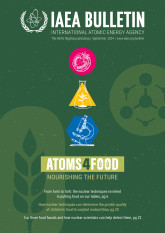The Food and Agriculture Organization of the United Nations (FAO) and the IAEA have successfully collaborated on the development and application of nuclear technologies in food and agriculture for 60 years. Atoms4Food is a new joint initiative that scales up these ground-breaking research and development (R&D) efforts to help address hunger and poverty.
Agrifood systems must feed growing populations amid ongoing global pressures such as environmental degradation, biodiversity loss, pollution and the climate crisis — all of which are driven by the systems themselves — and socioeconomic factors such as nutritional demand, persistent poverty levels and conflict. In 2023, between 713 and 755 million people went hungry. Billions more could not afford healthy diets.
To tackle today’s complex challenges, the FAO and the IAEA are aiming high by scaling up their partnership to help countries adopt nuclear, isotopic and associated technologies to make agrifood systems more efficient, inclusive, resilient and sustainable. These innovative approaches can enhance agricultural and livestock productivity and the management of natural resources, reduce food loss and waste, ensure food security and safety, improve nutrition and help vulnerable food-producing communities adapt to the impacts of the climate crisis.





